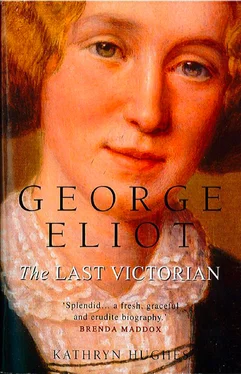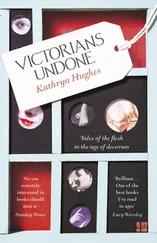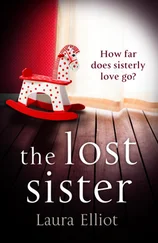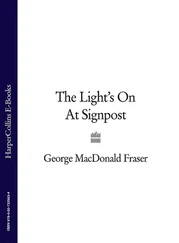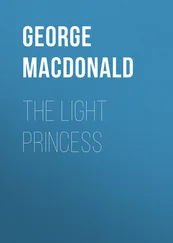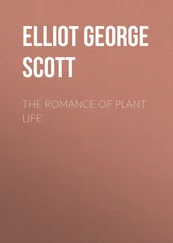Because of Eliot’s ‘scandalous’ private life, which actually the Queen did not think so very bad, there was no possibility of the two women meeting. Yet recognising their twinship, they stalked each other obliquely down the years. Eliot first mentions Victoria in 1848 when, having briefly caught the revolutionary mood, she speaks slangily in a letter of ‘our little humbug of a queen’. 2 Ironically, only eleven years later, Victoria had fallen in love with Eliot’s first full-length novel, Adam Bede , because of what she saw as its social conservatism, its warm endorsement of the status quo . The villagers of Hayslope, headed by Adam himself, reminded her of her beloved Highland servants, and in 1861 she commissioned paintings of two of the book’s central scenes by the artist Edward Henry Corbould.
George Eliot noticed how hard the Queen took the loss of Prince Albert in 1861 and, aware of the similarities in their age and temperament, wondered how she would manage the dreadful moment when it came to her. The Queen, in turn, was touched by the delicate letter of condolence that Eliot and Lewes wrote to one of her courtier’s children on his death and asked whether she might tear off their double signature as a memento. 3
The Queen’s daughters went even further. By the 1870s Eliot’s increasing celebrity and the evident stability of her relationship with Lewes meant that she was no longer a total social exile. Among the great and the good who pressed for an introduction were two of the royal princesses. Brisk and bright, Vicky and Louise lobbied behind the scenes for a meeting and then, in Louise’s case at least, dispensed with royal protocol by coming up to speak to George Eliot first. 4
The princesses were among the thousands of ordinary Victorians, neither especially clever nor brave, who ignored the early grim warnings of clergymen and critics about the ‘immorality’ of George Eliot’s life and work. By the 1860s working-class men and middle-class mothers, New Englanders (that most puritan of constituencies) and Jews, Italians and Australians were all reading her. Cheap editions and foreign translations carried George Eliot into every kind of home. Even lending libraries, those most skittishly respectable of ‘family’ institutions, bowed to consumer demand and grudgingly increased their stock of Adam Bede and The Mill on the Floss .
What is more, all these Victorians read the damnable George Eliot with an intensity and engagement that was never the case with Dickens or Trollope. While readers of Bleak House might sniff over the death of Jo and even stir themselves to wonder whether something might not be done for crossing-sweepers in general, they did not bombard Dickens with letters asking how they should live. That intimate engagement was reserved for Eliot, who alone seemed to understand the pain and difficulty of being alive in the nineteenth century. From around the world, men and women wrote to her begging for advice about the most personal matters, from marriage through God to their own poetry. Or else, like Princess Louise, they stalked her at concert halls, hoping for a word or a glance.
The worries which Eliot’s troubled readers laid before her concerned the dislocations of a social and moral world that was changing at the speed of light. Here were the doubts and disorientations that had been displaced from that triumphant version of Victorianism. An exploding urban population, for instance, might well suggest bustling productivity, but it could also mean a growing sense of social anomie. Rural communities were indeed invigorated by their new proximity to big towns, but they were also losing their fittest sons and daughters to factories and, later, to offices and shops. Meanwhile the suburbs, conceived as a rus in urbe , pleased no one, least of all George Eliot, who spent five years hating Richmond and Wandsworth for their odd mix of nosy neighbours and lack of real green.
For if in one way Victorians felt more separate from each other, in others they were being offered opportunities to come together as never before. It was not just the railway that was changing the psycho-geography of the country, bringing friends, enemies and business partners into constant contact. The postal service, democratised in 1840 by the introduction of the Penny Post, allowed letters to fly from one end of the country to the other at a pace that makes our own mail service look like a slowcoach. Then there was the telephone which, at the end of her life, George Eliot was invited to try. As a result of these changes Victorians found themselves pulled in two directions. Scattering from their original communities, they spent the rest of their lives trying to reconstitute these earlier networks in imaginary forms.
Science, too, was taking away the old certainties and replacing them with new and sometimes painful ones. It would not be until 1859 that Darwin would publish Origin of Species , but plenty of other geologists and biologists were already embracing the possibility that the world was older than Genesis suggested, in which case the Bible was perhaps not the last word on God’s word. Perhaps, indeed, it was not God’s word at all, but rather the product of man’s need to believe in something other than himself. This certainly was the double conclusion that Eliot came to during the early anonymous years of her career when she translated those seminal German texts, Strauss’s The Life of Jesus (1835–6) and Feuerbach’s The Essence of Christianity (1841). Her readers likewise wrestled with the awful possibility that there was no moral authority except the one which was to be found by digging deep within themselves. Not only did a godless universe lay terrifying burdens of responsibility upon the individual, but it unsettled the idea of an afterlife. To a culture which had always believed that, no matter how dismal earthly life might be, there was a reward waiting in heaven, this was a horrifying blow beside which the possibility that one was an ape paled into insignificance.
That much-vaunted prosperity turned out to be a tricky business too. For every Victorian who felt rich, there were two who felt very poor indeed, especially during the volatile 1840s and again in the late 1860s. During Eliot’s early years in the Midlands she saw the effect of trade slumps on the lives of working families. As a schoolgirl in Nuneaton she had watched while idle weavers queued for free soup; at home, during the holidays, she sorted out second-hand clothing for unemployed miners’ families. Even her own sister, married promisingly to a gentlemanly doctor, found herself as a widow fighting to stay out of the workhouse.
To middle-class Victorians these sights and stories added to a growing sense that they were not, after all, in control of the economic and social revolution being carried out in their name. Getting the vote in 1832 had initially seemed to give them the power to reshape the world in their own image: the repeal of the Corn Laws in 1846 had represented a real triumph of urban needs over the agricultural interest. But it soon became clear that early fears that 1832 would be the first step towards a raggle-taggle democracy were justified. On three occasions during the ‘hungry forties’ working-class men and women rallied themselves around the Charter, a frightening document demanding universal suffrage and annual parliaments. By the mid-186os, with the economy newly unsettled, urban working men were once again agitating violently for the vote.
These were worrying times. The fat little figure of the Queen was not enough to soothe Victorians’ fears that the blustery world in which they lived might not one day blow apart completely. In fear and hope they turned to the woman whose name they were initially only supposed to whisper and whose image they were seldom allowed to see. George Eliot’s novels offered Victorians the chance to understand their edginess in its wider intellectual setting and to rehearse responses by identifying with characters who looked and sounded like themselves. Thanks to her immense erudition in everything from theology to biology, anthropology to psychology, Eliot was able to give current doubts their proper historic context. Dorothea’s ardent desire to do great deeds, for instance, is set alongside St Teresa’s matching passion in the sixteenth century and their contrasting destinies explained. In the same way Tom Tulliver’s battles with his sister Maggie are understood not just in terms of their individual personalities, but as the meeting point of several arcs of genetic, cultural, and family conditioning at a particular moment in human history.
Читать дальше
